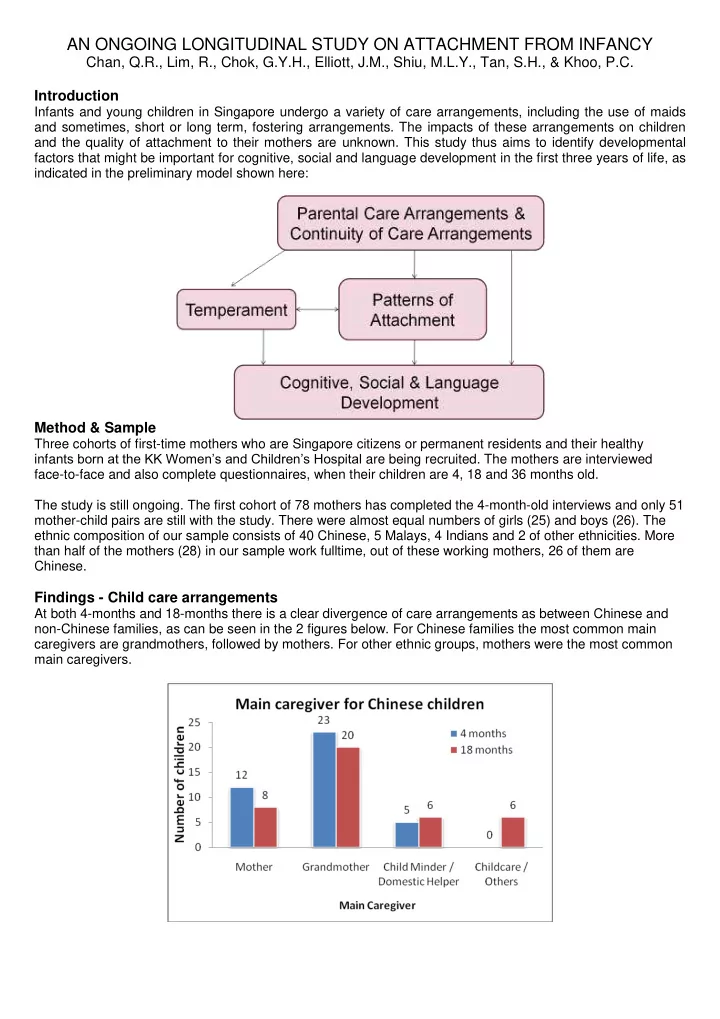

AN ONGOING LONGITUDINAL STUDY ON ATTACHMENT FROM INFANCY Chan, Q.R., Lim, R., Chok, G.Y.H., Elliott, J.M., Shiu, M.L.Y., Tan, S.H., & Khoo, P.C. Introduction Infants and young children in Singapore undergo a variety of care arrangements, including the use of maids and sometimes, short or long term, fostering arrangements. The impacts of these arrangements on children and the quality of attachment to their mothers are unknown. This study thus aims to identify developmental factors that might be important for cognitive, social and language development in the first three years of life, as indicated in the preliminary model shown here: Method & Sample Three cohorts of first-time mothers who are Singapore citizens or permanent residents and their healthy infa nts born at the KK Women’s and Children’s Hospital are being recruited. The mothers are interviewed face-to-face and also complete questionnaires, when their children are 4, 18 and 36 months old. The study is still ongoing. The first cohort of 78 mothers has completed the 4-month-old interviews and only 51 mother-child pairs are still with the study. There were almost equal numbers of girls (25) and boys (26). The ethnic composition of our sample consists of 40 Chinese, 5 Malays, 4 Indians and 2 of other ethnicities. More than half of the mothers (28) in our sample work fulltime, out of these working mothers, 26 of them are Chinese. Findings - Child care arrangements At both 4-months and 18-months there is a clear divergence of care arrangements as between Chinese and non-Chinese families, as can be seen in the 2 figures below. For Chinese families the most common main caregivers are grandmothers, followed by mothers. For other ethnic groups, mothers were the most common main caregivers.
Care arrangements seemed reasonably constant over the 18 months. A majority of children, 33 out of the 51, experienced 1 or no change in their care arrangements. Findings - Temperament Temperament of the children at both interviews was measured with the Short Temperament Scales (Sanson, Prior & Garino, 1987). Mothers’ ratings of their children’s temperament on the rhythmicity subscale were similar at the two interviews. However, statistical analyses show that mothers rated their children significantly less approaching, less cooperative, and more irritable at the 18-month-old interview. Our findings suggest that there are significant changes in temperament scores of children between 4 months and 18 months, which is in line with research suggesting that temperament in the early stages of infancy is not stable (Pedlow et al ., 1993; Koniak-Griffin & Rummel, 1998; Hagekull & Bohlin, 1981). This finding that temperament is not stable with children during infancy may be because as children get older, they are able to vocalize their likes and dislikes, have their own preference and are more mobile. Parents might find them more difficult to deal with, hence the changes in ratings. Alternatively, the difference in ratings may be due to the mothers’ perception being affected b y them spending less time with their children after returning to work at the end of their maternity leave. Findings - Attachment Attachment of the children to their mothers was measured by the Attachment Q-Set developed by Waters and Dean (1985). Mothers ranked descriptive statements about children’s behavior according to how characteristic each statement was of their children. The scores generated from the mothers’ ranking were correlated with scores generated by a panel of experts. The higher the correlation of mothers’ ranking was with the experts’ ranking, the more secure a child was judged to be. Evidently, the children generally did not score highly on attachment security, since for the great majority the correlation was low or even negative.
Comparing the security scores of children with mothers as their main caregivers and children whose main caregivers are not mothers, no significant difference was found for the security scores of these two groups. Attachment security to mothers does not seem to be related to whether mothers or others were the main caregivers. However, the number in our sample is small and differences may still appear as data from other cohorts becomes available. However, the attachment security found with children in our sample seems low. There may be other aspects of caregiving influencing attachment security scores. Conclusion There are cultural differences in caretaking practices. The most common main caregivers for the children up to 18 months were grandmothers and mothers for Chinese and non-Chinese families respectively. Children experienced few or no changes in their caregivers. Mothers rated their children significantly less approaching, less cooperative and more irritable at 18 months, indicating that temperament is not completely stable at this stage, which is in line with other research. Attachment based on the mothers’ ranking was not highly correlated with the experts’ secure benchmark , suggesting security of attachment is low. References Hagekull, B., & Bohlin, G. (1981). Individual stability in dimensions of infant behaviour. Infant Behavior and Development, 4 , 97-108. Koniak-Griffin, D., & Rummel, M. (1988). Temperament in infancy: Stability, change and correlates. Maternal- Child Nursing Journal, 17 , 25-40. Sanson, A., Prior, M., & Garino, E. (1987). The structure of infant temperament: Factor analysis of the revised infant temperament questionnaire. Infant Behavior and Development , 10, 97-104. Pedlow, R., Sanson, A., Prior, M., & Oberklaid, F. (1993). Stability of maternally reported temperament from infancy to 8 years. Developmental Psychology, 29 , 998-1007. Waters, E., & Deane, K. (1985). Defining and assessing individual differences in attachment relationships: Q- methodology and the organization of behavior in infancy and early childhood. In I. Bretherton & E. Waters (Eds.), Growing points of attachment theory and research . Monographs of the Society for Research in Child Development, 50 (Serial No. 209). For more information, please email info@childrensociety.org.sg
Recommend
More recommend